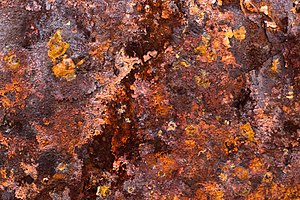
Back Roes Afrikaans Robín AN صدأ Arabic ܫܘܚܬܐ ARC Кьаву AV Pas Azerbaijani پاسلانما AZB Takla BCL Іржа Byelorussian Ръжда Bulgarian
This article needs additional citations for verification. (June 2012) |

| Steels |
|---|
 |
| Phases |
| Microstructures |
| Classes |
| Other iron-based materials |
Rust is an iron oxide, a usually reddish-brown oxide formed by the reaction of iron and oxygen in the catalytic presence of water or air moisture. Rust consists of hydrous iron(III) oxides (Fe2O3·nH2O) and iron(III) oxide-hydroxide (FeO(OH), Fe(OH)3), and is typically associated with the corrosion of refined iron.
Given sufficient time, any iron mass, in the presence of water and oxygen, could eventually convert entirely to rust. Surface rust is commonly flaky and friable, and provides no passivational protection to the underlying iron, unlike the formation of patina on copper surfaces. Rusting is the common term for corrosion of elemental iron and its alloys such as steel. Many other metals undergo similar corrosion, but the resulting oxides are not commonly called "rust".[1]
Several forms of rust are distinguishable both visually and by spectroscopy, and form under different circumstances.[2] Other forms of rust include the result of reactions between iron and chloride in an environment deprived of oxygen. Rebar used in underwater concrete pillars, which generates green rust, is an example. Although rusting is generally a negative aspect of iron, a particular form of rusting, known as stable rust, causes the object to have a thin coating of rust over the top. If kept in low relative humidity, it makes the "stable" layer protective to the iron below, but not to the extent of other oxides such as aluminium oxide on aluminium.[3]
- ^ "Rust, n.1 and adj". OED Online. Oxford University Press. June 2018. Retrieved 7 July 2018.
- ^ "Interview, David Des Marais". NASA. 2003. Archived from the original on 2007-11-13.
- ^ Ankersmit, Bart; Griesser-Stermscheg, Martina; Selwyn, Lindsie; Sutherland, Susanne. "Rust Never Sleeps: Recognizing Metals and Their Corrosion Products" (PDF). depotwijzer. Parks Canada. Archived (PDF) from the original on 9 August 2016. Retrieved 23 July 2016.